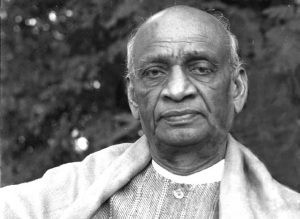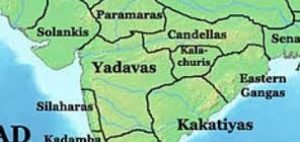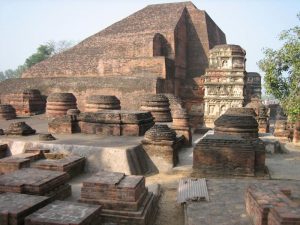BHAGAT SINGH
The name Bhagat Singh has become a synonym of revolution. He was one of the great revolutionaries who made supreme sacrifice for the nation. Thousands of young people sacrificed their lives in the altar of India’s liberation struggle but the name Bhagat Singh has a special place in the history of our independence. No other young revolutionary of India got much empathy in the minds of the people of India like Bhagat Singh. Still he is an inspiration source for the patriotic people of our motherland. It is important today to study the contributions of Bhagat Singh and his comrades when our country is again falling under the grip of imperialism and its designs. Unfortunately Bhagat Singh did not have much place in the history textbooks. There was a concerted effort to underestimate the contributions of revolutionaries who sacrificed everything for the liberation of our motherland.
Bhagat Singh came from a family of patriots and freedom fighters. His uncle, Ajit Singh was a pioneer in opposing the Colonization Act 1905 and had to remain in exile till the country gained independence. His father also was an active participant in the struggle for the liberation of the country from the colonial rule. While as a student Bhagat Singh came under the influence of the revolutionaries. The October revolution led by Lenin attracted Bhagat Singh and he started to collect and read the literatures about socialism and socialist revolution. The years of the twenties in general and those of 1928-30 in particular were of great significant in the history of India’s freedom struggle.
Due to the failure of first non-cooperation movement, the revolutionaries of that period were frustrated and started to think about some alternative action plan. The formation of the Hindustan Republican Association, the Hindustan Socialist Republican Army and the Naujawan Bharat sabha (All India Youth League) all happened during this period. Bhagat Singh and his comrades were imbued with the ideas of revolution and socialism. The manifesto of HRA says “The immediate object of the revolutionary party in the domain of politics is to establish a federal republic of the United States of India by an organized and armed revolution. The basic principle of this republic shall be universal suffrage and the abolition of all system, which makes the exploitation of man by man possible. In this republic the electors shall have the right to recall their representatives if so desired, otherwise the democracy shall be a mockery”. India could not think about such ideas even after sixty years of independence!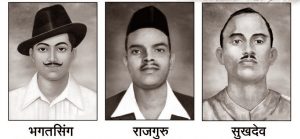
The protest against the visit of Simon Commission turned into violence. Lala Lajpath rai died due to police lathicharge. The country witnessed unprecedented protest rallies. Bhagat Singh and his associates threw bombs in Central Assembly. A few days’ later bombs exploded in the Central Assembly they were arrested. The trial began in 1929 July. The farcical trial ended in October 1930 awarded death sentence to Bhagat Singh, Rajguru and Sukhdev. The charge was conspiracy to overthrow the British rule and murder of a British official. They accepted the verdict with raising slogans. A few days before the execution Bhagat Singh wrote a letter to the British authorities demanding that as he and his two condemned comrades were prisoners of war, they should not be hanged but that the sentence should be executed by a firing squad of the British army. This was the unconquerable spirit and stuff of which Bhagat Singh was made.
The conduct of Bhagat Singh and his comrades during their historic trial at Lahore created new precedents of revolutionary behaviour. They were making use of the British courts as a forum to address the people, broadcast their revolutionary views and ideology. This was something different from the nationalist tradition set by Mahatma Gandhi. They appeared everyday in the nationalist press and every activity of theirs was watched by lakhs of people. Their revolutionary declarations were also denied publicly but this did not restrain them. Intent upon every aspect of British Court, justice and jail administration, they fought against every humiliating restriction, every discriminatory rule and demanded proper status for freedom fighters in jail. They refused to be treated as common criminals and demanded treatment in consonance with dignity and prestige of the freedom struggle. During the trial days Bhagat Singh and his comrades were asked to refrain from raising revolutionary slogans in the court. But they continued to shout ‘Inqilab Zindabad’. They were beaten and handcuffed in the court; they were assaulted with lathis till they bled profusely and fell unconscious. Bhagat Singh and his comrades succeeded in completely exposing the anti-Indian and arbitrary character of British justice in India and the barbarities of the British Indian jails. This was the aim of their fight for which they prepared to undergo all the tortures. They turned their trial into a public trial of the British government.
In a joint statement before the trial court, Bhagat Singh and Batukeswar Dutt explained why they threw the bombs in the Central Assembly. They said their purpose was not to harm anyone but to expose the dependent character of the Legislative assembly which was being paraded by the British as a Parliament create the belief that India was being democratically governed. The statement further says’A radical change, therefore, is necessary and it is the duty of those who realize this to reorganize society on a socialistic basis. Unless this thing is done and exploitation of man by man and nation by nations is brought to an end, sufferings and carnage with which humanity is threatened cannot be prevented. All talk of ending war and ushering in an era of universal peace is undisguised hypocrisy”. In the statement they explained about their concept about revolution. They said that” By revolution, we mean the ultimate establishment of an order of the society which may not be threatened by such breakdown and in which the sovereignty of the proletariat should be recognized and a world federation should redeem humanity from the bondage of capitalism and the misery of imperial wars” Bhagat Singh symbolized his struggle in the slogan he raised after he threw a bomb in the Legislative Assembly of Delhi- “Long Live revolution” (Inquilab Zindabad), a slogan totally unfamiliar at that time to the Indian people.
Bhagat Singh was not content with slogans. He embodied the indomitable courage, the death-defying spirit, the capacity to sacrifice everything and unflinching courage in the face of torture. In 1930 July Bhagat Singh told some of his fellow comrades in jail said, “This is the highest award for patriotism and I am proud that I am going to get it. They think that by destroying my terrestrial body they will be safe in this country. They are wrong. They may kill me, but they cannot kill my ideas. They can crush my body, but they will not be able to crush my spirit. My ideas will haunt the British like a curse till they are forced to run away from here. But this is one side of the picture. The other side is equally bright. Bhagat Singh dead will be more dangerous to the British enslavers than Bhagat Singh alive. After I am hanged, the fragrances of my revolutionary ideas will permeate the atmosphere of this beautiful land of ours. It will intoxicate the youth and make him mad for freedom and revolution and that will bring the doom of the British imperialist nearer. This is my firm conviction. I am anxiously waiting for the day when I will receive the highest award for my services to the country and my love for my people”. Now this is the duty of the present day youth to fulfill the dreams and aspirations of Shaheed-eAzam Bhagat Singh by organizing revolutionary movement against neo imperialism and neo colonialism. In this context the three slogans rose by Bhagat Singh and his comrades Long live revolution, long live proletariat and own with imperialism -are still relevant.
Surya Sen (1894-1934)
Surya Sen(March 22, 1894 – January 12, 1934) (also known as Masterda Surya Sen) was a prominent Bengali freedom fighter, an Indian independence activist and the chief architect of anti-British freedom movement in Chittagong, Bengal (now in Bangladesh).He was born on 22 March 1894 in Chittagong district now in Bangladesh. He participated in nationwide non-cooperation movement as a revolutionary. He was arrested in February 1933 by British and was hanged on 12 January 1934.The Government of India released a commemorative stamp on him in 1977. Bangladesh issued a commemorative stamp on him in 1999.
Early life
His father’s name was Ramaniranjan. A resident of Noapara in Chittagong, he was a teacher by profession. He was initiated into revolutionary ideas in 1916 by one of his teachers while he was a student of Intermediate Class in the Chittagong College and joined the renowned revolutionary group Anushilan. But when he went to Behrampur College for BA course, came to know about Jugantar and became more inspired with their ideas. On his return to Chittagong in 1918, he organized Jugantar there. All revolutionary groups were using Indian National Congress as umbrella to work. Consequently in 1929, Surya Sen became the president of the Chittagong district committee of the Indian National Congress. He continued to organize the hardline patriotic organisations and first became a teacher of the National school in Nandankanan and then joined the Umatara School at Chandanpura. Hence, he was known as Mastarda (teacher brother).
By 1923 Surya Sen spread the revolutionary organization in different parts of Chittagong district. Aware of the limited equipment and other resources of the freedom fighters, he was convinced of the need for secret guerrilla warfare against the colonial Government. One of his early successful undertakings was a broad day robbery at the treasury office of the Bengal Assam Railway at Chittagong on December 23, 1923.
Chittagong armoury raid and its aftermath.
His major success in the anti-British revolutionary violence was the Chittagong Armoury Raid on April 18, 1930. Subsequent to the raid, he marched to the Jalalabad hills along with his fellow revolutionaries. After the battle with the British troops on April 22, he escaped from there. Surya Sen, being constantly followed up by the police, had to hide at the house of Sabitri Devi, a widow, near Patiya. A police and military force under Captain Cameron surrounded the house on 13 June 1932. Cameron was shot dead while ascending the staircase and Surya Sen along with Pritilata Waddedar and Kalpana Datta escaped to safety.
Surya Sen was always in hiding, moving from one place to another. Sometimes he used to take a job as a workman; sometimes he would take a job as a farmer, or milkman, or priest, houseworker or even as a pious Muslim. This is how he used to avoid being captured. Either because of money, or out of jealousy, or because of both, Netra Sen told the British Government that Surya Sen was at his house. As a result, the police came and captured him on February 16, 1933. This is how India’s supreme hero was arrested. But before Netra Sen was able to get his 10,000-rupee reward he was killed by the revolutionaries. This is how it happened. Netra Sen’s wife was all for Surya Sen, and she was horrified by her husband’s deed. She felt mortified by her husband’s betrayal of Surya Sen. One evening she was serving her husband food when a great admirer of Surya Sen came into the house. He was carrying a very big knife, which is called a “daa”. With one stroke of the dal he chopped off the head of Netra Sen in the presence of his wife. Then slowly and stealthily he went away.
When the police arrived to investigate, they asked Netra Sen’s wife if she had seen who the murderer was. She said, “I saw with my own eyes, but my heart will not permit me to tell you his name. I am sorry. I feel miserable that I was the wife of such a treacherous man, such an undivine man as Netra Sen. My husband betrayed the greatest hero of Chittagong. My husband betrayed a great son of Mother India. My husband cast a slur on the face of India. Therefore; I cannot tell the name of the person who took his life. He has definitely done the right thing. You can do anything with me. You can punish me, you can even kill me, but I shall never tell the name of the person who killed my husband. Our Master-da will be hanged, I know, but his name will forever be synonymous with India’s immortal freedom-cry. Everybody loves him. Everybody adores him. I, too, love him and adore him, for he is the brightest sun in the firmament of Chittagong. Surya means sun and he is truly our sun. “Tarakeswar Dastidar, the new president of the Chittagong Branch Jugantar Party, made a preparation to rescue Surya Sen from the Chittagong Jail. But the plot was unearthed and consequently frustrated. Tarakeswar and Kalpana along with others were arrested. Special tribunals tried Surya Sen, Tarakeswar Dastidar, and Kalpana Datta in 1933.
Surya Sen along with his Tarekeshwar Dastidar was hanged by the British rulers on January 12, 1934. Before the death sentence Surya Sen was brutally tortured. It was reported that the British executioners broke all his teeth with hammer and plucked all nails and broke all limbs and joints. He was dragged to the rope unconscious. After his death his dead body was not given any funeral. The prison authority, it was found later, put his dead body in a metallic cage and dumped into the Bay of Bengal.
His last letter to his friends, written on 11 January, stated, “Death is knocking at my door. My mind is flying away towards eternity …At such a pleasant, at such a grave, at such a solemn moment, what shall I leave behind you? Only one thing that is my dream, a golden dream-the dream of Free India…. Never forget the 18th of April, 1930, the day of the eastern Rebellion in Chittagong… Write in red letters in the core of your hearts the names of the patriots who have sacrificed their lives at the altar of India’s freedom.
Hindustan Socialist Republican Association
Hindustan Socialist Republican Association before 1928 was known as the Hindustan Republican Association. It is reckoned as one amongst the Indian independence associations during the time of freedom struggle. Bhagat Singh, Yogendra Shukla and Chandrasekar Azad were the key functionaries of Hindustan Socialist Republican Association. The group is also considered one of the first socialist organisations in India. HSRA was invigorated by the ideologies of the Bolsheviks involvement in the Russian Revolution of 1917.
Hindustan Socialist Republican Association was first launched during a meeting in Bholachang village, Brahamabaria subdivision, East Bengal. Praiseworthy freedom fighters like- Pratul Ganguly, Narendra Mohan Sen and Sachindra Nath Sanyal were present at the meeting. The association was formed as an outgrowth of the Anushilan Samiti. The party was established with the aim to organise armed revolution in order to end the colonial rule and establish a Federal Republic of the United States of India. The name Hindustan Socialist Republican Association was implicative after a similar revolutionary body in Ireland.
During that period Gandhiji had declared to cancel the Non-cooperation movement after the Chauri Chaura incident. This decision of his created a lot of rancour amongst the youngsters. Some of them had jeopardised their careers for the movement.As HSRA was a revolutionary group, they attempted to loot a train. They were informed that the train was transferring government money.On 9th August 1925, the revolutionists ransacked the train. This now famous incident is known as the Kakori train robbery.As a result of the Kakori train robbery case, Ashfaqullah Khan, Ramprasad Bismil, Roshan Singh, Rajendra Lahiri were hanged to death. It was an important setback for the Hindustan Socialist Republican Association.
Hindustan Socialist Republican Association was aiming to create a Federal Republic of the United States of India. But later they changed their focus towards creating an India based on the Socialist ideals of Lenin and Marx. Bhagat Singh declared this at the Ferozshah Kotla Ruins in Delhi on 9th September 1928. Afterwards, the association was renamed Hindustan Socialist Republican Association, from Hindustan Republican Association. HSRA in non-violent protest advancement against the Simon Commission at Lahore decided to support Lala Lajpat Rai. But in the protest procession, the police plunged into a mass lathicharge and the wounds imposed on Lalaji proved life-threatening to him. This incident was witnessed by Bhagat Singh and he swore to take revenge.
It was decided by Hindustan Socialist Republican Association that the attempt would be taken against J.A Scott, who had ordered the unlawful lathi-charge. Bhagat Singh, Rajguru, Chander Shekhar Azad and Jai Gopal were given the charge to execute the plan. It was designed that Jai Gopal would signal Bhagat Singh and Rajguru when J.A Scott would come out of his office. At the appointed time, on 17th December 1928 at Lahore, a British official J. P.Saunders, the A.S.P., a youngman of 21 but a probationer stepped out of his office. Raj Guru swooped on the British official with a pistol at Jai Gopal`s signal. The bullet perforated through his neck and almost killed him. Bhagat Singh also rushed and pounced on him and fired four or five shots.J.P.Saunders died on the spot. Incidentally it was a terrible miscalculation on the part of Jai Gopal. He failed to differentiate between Scott and Saunders. Chanan Singh- a head constable came forth to chase Bhagat Singh and Raj Guru, but Chandra Shekhar Azad shot Chanan down. The next day, Hindustan Socialist Republican Association came forward in public and in their proclamation said, “Inquilab Zindabad (Long Live Revolution). We don`t enjoy killing an individual, but this individual was ruthless, mean and part and parcel of an unjust system. It is necessary to destroy such a system. This man has been killed; because he was a cog in the wheel of British rule. This government is the worst of all governments.” Another significant action carried out by the Hindustan Socialist Republican Association was the Assembly Bomb Case. The association adjudicated to burst a blank bomb in the Central Assembly in Delhi, in order to express opposition against the tyrannical legislation and arouse public opinion. Bhagat Singh and Batukeshwar Dutt offered to carry out the bombing and get arrested. The ideology behind the bombing was `to make the deaf government hear the voices of its oppressed people`. Bhagat Singh also believed that `the only way to successfully convey his message to the public of India was to propaganda from Court`. He believed that since all statements were registered in Court and then promulgated, they could benefit support for their crusade.
On April 8th 1929 when Vitthal Bhai Patel, President of the Central Assembly, moved up to give his ruling on failing to get an authority from the government that the bill would not be imposed retrospectively, a bomb was detonated near the empty treasure benches, followed by another bomb explosion. Panic predominated everywhere. Nobody got killed as it was not thought of. The hall got filled with smoke. Bhagat Singh and BK Dutt started crying out “Long Live Revolution, Down with Imperialism” as the smoke cleared. They also threw red leaflets on the floor, which began with the slogan of a French revolutionary “It needs a loud voice for a deaf to hear”.
On April 15th 1929, police raided the bomb factory of HSRA. As a result Kishori Lal, Sukhdev and Jai Gopal were arrested. The Assembly Bomb Case trial was started following this raid.On 23rd March 1931 Bhagat Singh, Sukhdev and Rajguru were hanged. The great nationalist Baikuntha Shukla was also hanged for murdering Phanindrananth Ghosh who had become a government approver which later on led to the hanging of Bhagat Singh, Sukhdev and Rajguru.Baikuntha Shukla joined the freedom struggle at a young age and took active part in the `Salt Satyagraha` of 1930.He was also associated with revolutionary organisations like the Hindustan Seva Dal and Hindustan Socialist Republican Association.
Bhagat Singh, Rajguru and Sukhdev were executed in 1931, as a result of their trial in the `Lahore conspiracy case`. Their death penalty gave birth to tremendous agitation throughout the country. Phanindrananth Ghosh was a key figure of the Hindustan Socialist Republican Association. By turning into an approver, he betrayed the cause of the party. Baikuntha Shukla was given the charge to execute Phanindrananth Ghosh as an act of ideological revenge. He completed it in a successful manner on 9th November 1932.As a result Baikuntha Shukla was arrested and tried for murder. On May 14th 1934; Baikunth was convicted and hanged in Gaya Central Jail only at a young age of 28.
Another key revolutionary of Hindustan Socialist Republican Association, Chandrasekar Azad was killed on 27th February 1931 in a gunfight with the police. With the death of Chandrashekar Azad and the hanging of its popular activists, Bhagat Singh, Sukhdev and Rajguru, the fate of the association was yet indecipherable. Hindustan Socialist Republican Association was always in the forefront of revolutionary movements in the northern parts of India. The association consisted of younger generations of U.P, Bihar, Punjab, Bengal and Maharashtra. The group possessed ideals, which were directly opposite to Mahatma Gandhi`s Congress.

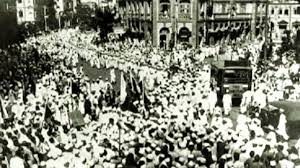 separate state. Morarji Desai did not listen them and police repression resulted in death of five to eight students. It triggered massive protests across the state. Indulal Yagnik came out of his retirement from politics and founded Mahagujarat Janata Parishad to guide movement. Many protesters including Indulal Yagnik and Dinkar Mehta, Dhanvant Shroff were arrested and kept at Gaekwad Haveli in Ahmedabad for a few days and later imprisoned in Sabarmati Central Jail for three and half months. Protest also spread in other parts of the state which forced Morarji Desai to go on week-long fast. People did not turned up to support him during fast and stayed in home following self-imposed curfew, Janata Curfew. Just before the declaration of carving three states as Nehru suggested, 180 members of Parliament suggested return to bilingual Bombay state together. There was conflict over Mumbai and Dang which was solved through discussions. Gandhian activist Ghelubhai Nayak actively lobbied for accession of Dang in Gujarat. Mumbai went to Maharashtra and Dang went to Gujarat.
separate state. Morarji Desai did not listen them and police repression resulted in death of five to eight students. It triggered massive protests across the state. Indulal Yagnik came out of his retirement from politics and founded Mahagujarat Janata Parishad to guide movement. Many protesters including Indulal Yagnik and Dinkar Mehta, Dhanvant Shroff were arrested and kept at Gaekwad Haveli in Ahmedabad for a few days and later imprisoned in Sabarmati Central Jail for three and half months. Protest also spread in other parts of the state which forced Morarji Desai to go on week-long fast. People did not turned up to support him during fast and stayed in home following self-imposed curfew, Janata Curfew. Just before the declaration of carving three states as Nehru suggested, 180 members of Parliament suggested return to bilingual Bombay state together. There was conflict over Mumbai and Dang which was solved through discussions. Gandhian activist Ghelubhai Nayak actively lobbied for accession of Dang in Gujarat. Mumbai went to Maharashtra and Dang went to Gujarat.
 against the Mughal empire. Aurangzeb’s conflicts with the Rajputs, which commenced in the early 1680s, henceforth became a contributing factor towards the downfall of the Mughal empire. In the 18th century, the Rajputs came under influence of the Maratha empire. By the late 18th century, the Rajput rulers begin negotiations with the East India Company and by 1818 all the Rajput states had formed an alliance with the company.
against the Mughal empire. Aurangzeb’s conflicts with the Rajputs, which commenced in the early 1680s, henceforth became a contributing factor towards the downfall of the Mughal empire. In the 18th century, the Rajputs came under influence of the Maratha empire. By the late 18th century, the Rajput rulers begin negotiations with the East India Company and by 1818 all the Rajput states had formed an alliance with the company.